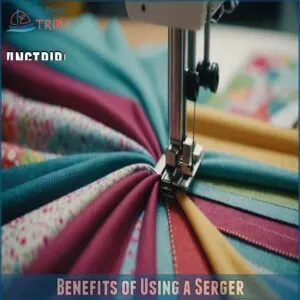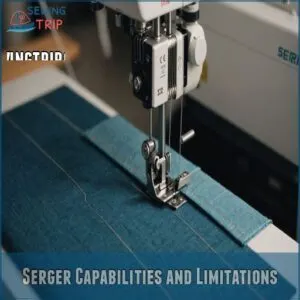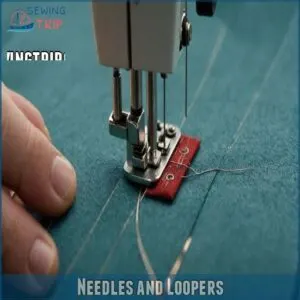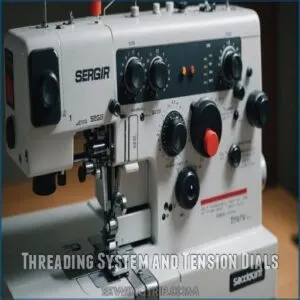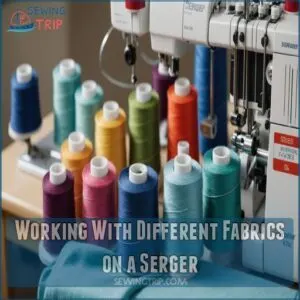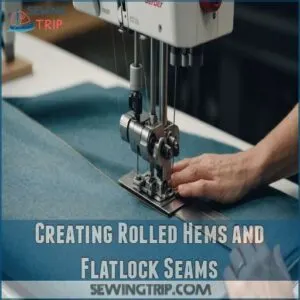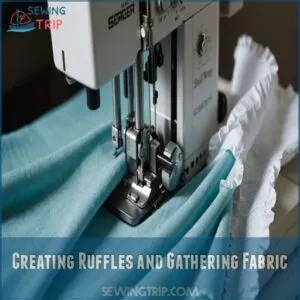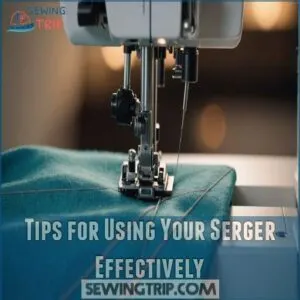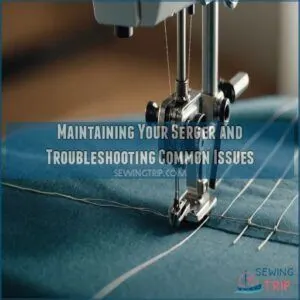This site is supported by our readers. We may earn a commission, at no cost to you, if you purchase through links.
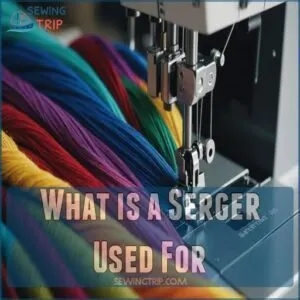
Imagine this: you’ve sewn a fabulous shirt, but those frayed edges scream "homemade."
Enter the serger, your sewing sidekick! It trims, overlocks, and finishes seams all in one go, giving your projects that store-bought look.
It’s perfect for sewing stretchy fabrics like knits without popping stitches—something a regular machine might bungle.
Sergers also ace decorative edges, making your tablecloths and curtains a cut above.
Got scraps of fabric? No problem! A serger makes tidy work of any mess.
Curious about mastering this sewing marvel? Stick around, and your sewing game could skyrocket!
Table Of Contents
- Key Takeaways
- What is a Serger Used For
- Benefits of Using a Serger
- Serger Capabilities and Limitations
- Choosing The Right Serger for Your Needs
- Understanding Serger Parts and Functions
- Working With Different Fabrics on a Serger
- Advanced Serger Techniques and Stitches
- Tips for Using Your Serger Effectively
- Maintaining Your Serger and Troubleshooting Common Issues
- Frequently Asked Questions (FAQs)
- Conclusion
Key Takeaways
- Finish seams like a pro: A serger trims, overlocks, and finishes seams in one step, preventing fraying and giving projects a polished look.
- Master stretchy fabrics: It’s perfect for sewing knits and other stretchy materials, offering durable, flexible seams that a regular sewing machine might struggle with.
- Create decorative edges: Sergers excel at producing decorative finishes, like rolled hems and flatlock seams, enhancing the appearance of your projects.
- Specialized yet essential: While it can’t replace a sewing machine for tasks like buttonholes, a serger is indispensable for professional finishes and handling specialized sewing tasks.
What is a Serger Used For
Imagine this: you’re diving into sewing, and someone mentions a serger, leaving you scratching your head. What’s it for? A serger, or overlocker, is your secret weapon for those polished seams that look store-bought.
It’s like a sewing machine on steroids, using multiple threads to neatly wrap fabric edges.
Perfect for stretchy knit fabrics, it’s essential if you’re tackling projects that require durable, flexible seams. Think of it as your best friend in the battle against frayed edges.
Unlike regular sewing machines, sergers specialize in achieving a tidy finish, often in one swoop. Beginners might find it tricky at first, but with some practice—and the right serger accessories and maintenance—it’s a game-changer for your sewing adventures!
Benefits of Using a Serger
So, you want to know why a serger’s worth the hype?
You’ll love how it finishes seams flawlessly, preventing those annoying frayed edges and giving your projects a professional, store-bought look.
Finishing Seams and Preventing Fraying
Ever felt frustrated with fraying fabric edges?
A serger is your best buddy for finishing seams neatly.
It uses overlock stitches to wrap those pesky edges, giving your projects a professional flair.
Here’s why you’ll love it:
- Seam finishes that impress
- Reliable fraying prevention
- Works seamlessly on various fabric types
Who knew sewing could be so satisfying?
Sewing Knit Fabrics and Stretchy Materials
Step away from fraying edges and enter the realm of stretchy fabrics.
Sergers make sewing knits a breeze with their magical overlock stitch, which can be adjusted in width for various applications and is often found on a sewing machine stitch chart. Sergers make sewing knits a breeze with their magical overlock stitch.
This stitch stretches, making it perfect for leggings and T-shirts.
Grapple with serger tension for knits, and you’ll conquer even the trickiest fabrics.
Choose wisely; the right serger brings your sewing dreams to life!
Creating Professional-Looking Finishes
With a serger, you can create professional-looking finishes that elevate your sewing projects.
You can find various serger hems products online, such as at serger hems kits.
Imagine transforming raw edges into polished seams with overlock stitches.
It’s like turning a pumpkin into a carriage!
Rolled hems and flatlocks add finesse, while serger stitches seal the deal, giving your fabric a durable edge.
Your creations won’t just look homemade—they’ll shine with expert precision.
Serger Capabilities and Limitations
With a serger by your side, you can masterfully finish fabric edges, sew stretchy materials, and create stunning rolled hems.
But remember, while sergers are sewing superheroes in many situations, they can’t topstitch or make buttonholes, so keep your regular sewing machine handy!
Finishing Raw Fabric Edges
There’s nothing quite like the tidy look sergers give to raw fabric edges, making your projects look polished. You can forget about pesky fraying!
Here’s what makes sergers a must-have:
- Serger stitch types create strong seams.
- Fabric fray prevention keeps edges neat.
- Overlock stitch details finish off seams professionally.
Without a serger, you can still finish raw edges of fabric using techniques like pinking shears, zigzag stitches, and hem tape.
Trust me, they’re game-changers!
Creating Rolled Hems and Decorative Stitches
Imagine whipping up ethereal rolled hems or eye-catching decorative stitches on lightweight fabrics with a serger’s strong stitches, ideal for sewing overlock seams Sewing Serger Benefits.
Adjusting your serger’s proper serger fabric tension is key to this task, allowing you to fine-tune the machine’s performance.
A serger handles this task by adjusting tension settings and stitch types, ensuring a flawless finish.
It’s like having a magic wand for sewing.
Experiment with fabric choices, and you’ll discover new possibilities that elevate your sewing projects, adding both flair and elegance effortlessly!
What Sergers Can’t Do
That’s a great question! A serger’s a whiz at overlock stitches and finishing knit fabrics, but it won’t replace your sewing machine entirely.
You can’t sew buttonholes or do topstitching with it. Forget about quilting or invisible zippers too!
It’s a specialized tool, not a one-stop shop for all your sewing needs. Think of it as a super-efficient partner, not a replacement.
Choosing The Right Serger for Your Needs
Finding the right serger is like choosing the perfect pair of scissors—it’s all about what fits your sewing style.
Whether you’re on a budget or dreaming of air-threading magic, there’s a serger out there that’ll keep your fabrics looking fabulous.
Budget-Friendly Options
Considering serger capabilities, it’s smart to explore budget-friendly options.
Tackle sewing projects without breaking the bank by considering these choices, and don’t forget to check out the best sergers reviewed to find the most suitable one for your needs.
- Entry-level models: Reliable and efficient for serger basics.
- Affordable sergers: Perfect for mastering essential overlock stitches.
- Used sergers: Cost-effective with a bit of character.
- Cheap sergers: Great for starting your sewing journey on a budget.
Air-Locking Sergers With Advanced Features
Imagine this: you’re diving into sewing projects with an air-locking serger packed with advanced features.
Air-threading simplifies setup, while auto-tensioning handles stitch perfection.
To find the perfect air-lock serger for your needs, check out Air-lock serger reviews to make an informed decision.
Comparison Chart
| Feature | Benefit |
|---|---|
| Air-Threading | Easier threading |
| Auto-Tension | Perfect stitch |
| Maintenance | Less frequent upkeep |
These extras make serging a breeze, enhancing your crafting journey effortlessly.
Understanding Serger Parts and Functions
To really get the most out of your serger, you need to know its main components like needles, loopers, and the threading system.
Don’t worry, understanding these parts is easier than finding that one sock that always disappears in the laundry!
Needles and Loopers
After you pick a serger, get buddy-buddy with needles and loopers.
They’re your backstage pass to perfect stitches.
Different needle types and sizes match fabrics, while loopers use magic—well, thread—to stitch it all together.
Experimenting with tension adjustments can prevent headaches.
Each click, twist, and turn leads to smoother sewing adventures.
Threading System and Tension Dials
Getting those needles and loopers doing their thing is half the battle.
But mastering the threading system and tension dials is where the real magic happens, as issues like thread tension dial problems can make or break your serger stitches.
Mastering the serger threading system and tension dials is where the real magic happens.
Mastering the serger threading system and tension dials is where the real magic happens.
Mastering the serger threading system and tension dials is where the real magic happens, crafting flawless serger stitches.
Feed System and Cutting Mechanism
With the fabric smoothly feeding through, you’ll master your serger!
Different feed dog types impact fabric movement.
Adjusting the knives is key for clean cuts; regular cutting blade maintenance prevents jams.
The differential feed, a serger feature, lets you control gathering.
Understanding your serger’s threading path is essential for consistent stitching.
It’s all about control and precision!
Working With Different Fabrics on a Serger
When you’re working with a serger, you’ll find it’s perfect for handling both stretchy knit fabrics and fray-prone woven materials.
Imagine transforming a stack of fabric odds and ends into a wearable masterpiece, all by adjusting a few settings for each fabric type!
Serging Knit Fabrics and Stretchy Materials
You’re tackling knit fabrics? A serger’s got your back! Let’s break it down:
- Set the serger tension guide right for those stretchy fabrics.
- Check that serger seam allowance matches your fabric’s needs.
- Enjoy the overlock stitch benefits—it stretches as you sew, perfect for t-shirts and leggings!
You’ll find sewing knits feels like a breeze.
Serging Woven Fabrics and Preventing Fraying
After mastering stretchy fabrics, let’s handle woven ones.
They’re not as forgiving, so mind your seam allowances.
To prevent fraying, a three-thread overlock stitch works wonders.
Adjust your serger thread tension for that perfect finish.
Don’t let those edges unravel like your plans for a relaxing weekend!
With these woven fabric serging tips, your project’s rock solid.
Advanced Serger Techniques and Stitches
You’re ready to take your serger skills to the next level, where creating rolled hems and flatlock seams becomes second nature.
Imagine the creative possibilities with advanced techniques that let you add ruffles and gather fabric like a pro, making your projects truly stand out!
Creating Rolled Hems and Flatlock Seams
Imagine you’re tackling fabric edges with finesse.
Rolled hems add that delicate touch to scarves or blouses, needing just a twist of tension adjustments and your serger’s magic.
Flatlock seams, on the other hand, lay flat and smooth.
Perfect for sportswear, these seam variations integrate fabrics seamlessly.
With a bit of practice, these techniques become second nature.
Creating Ruffles and Gathering Fabric
Once you’ve mastered flatlock seams, let’s tackle adding flair with ruffles!
Using your serger’s stitch finger to guide the looper thread allows for precise control over stitch length and spacing, which is crucial for achieving the perfect seam finish, especially when working with differential feed mechanics. Using your serger’s differential feed, create effortless gathering and ruffle variations.
Adjust serger settings by considering factors like managing thick seams, and explore fabric choices to see how they impact the final look.
Troubleshooting ruffles can be as easy as tweaking the tension.
With practice, you’ll sew stunning knits and gather fabric like a pro.
Tips for Using Your Serger Effectively
So, you’re ready to conquer your serger?
Let’s get you up to speed with some handy tips on threading, tension, and smoothly starting and stopping those seams – it’s easier than you think!
Threading and Tensioning Your Serger
Why’s threading your serger such a challenge?
Don’t fret!
Use colored threads to easily spot tension problems.
Pay attention to your manual for threading order—it’s like a serger secret code.
Tension adjustments are key; too tight, and threads snap; too loose, and it’s spaghetti city!
Regular serger maintenance keeps everything snazzy and your overlock stitch flawless.
Starting and Stopping a Seam on Your Serger
Get those professional-looking seams flowing smoothly with your serger.
When constructing garments, keep in mind that Sergers for Garment Construction can efficiently join fabric pieces together to provide a flat, finished edge that’s both durable and stretchy.
To start a seam, keep serger thread tails tucked under.
Secure seams like a pro by gently backtacking at the end.
For a clean finish:
- Adjust your serger tension for balance.
- Use the overlock stitch for sturdy edges.
- Practice with scrap fabric to perfect your technique.
Happy serging!
Maintaining Your Serger and Troubleshooting Common Issues
Keeping your serger in top shape with regular maintenance, like oil changes and tension checks, can feel like a chore, but it’s the secret to preventing those pesky stitching woes.
Just like you wouldn’t skip an oil change on your car, don’t let your serger miss out on a little TLC to keep it humming smoothly during your creative ventures.
Regular Maintenance and Oil Changes
You’ve mastered threading, now let’s keep your serger humming with regular maintenance.
Think of it like caring for your car—oil changes are key.
Use the right serger oil types, follow a maintenance schedule, and wipe away dust bunnies.
These simple steps prevent common problems, so your overlocker runs smoother than your morning coffee routine.
Checking Tension and Adjusting Settings
Mastering the art of threading tension, as described in sewing machine threading basics, requires patience and practice, and the dance of thread tension and stitch length is essential for perfect serging.
Imagine your serger’s settings like tuning a guitar—too loose, and it’s all jangled; too tight, and it’ll snap!
Adjust for fabric weight and needle type, and don’t shy away from tweaking the differential feed to keep those stitches singing harmoniously.
Frequently Asked Questions (FAQs)
What is a serger machine & how does it work?
Picture a sewing machine’s cool sibling that loves finishing touches!
A serger trims and seals fabric edges with overlock stitches, creating professional looks.
It’s perfect for stretchy fabrics, adding strength and beauty to your crafts.
What does a serger do?
A serger trims fabric edges while stitching them in a single step, creating neat, professional seams.
It’s perfect for knits, stretchy fabrics, and preventing fraying, making your homemade projects look as polished as store-bought garments.
What is a serger in sewing?
Jump into the serger world and discover this magical machine’s power!
It turns fabric edges into artwork with overlock stitches, giving professional finishes.
Imagine zipping through knits and preventing frays in style—your sewing projects will thank you!
Why should you buy a serger machine?
To achieve professional-looking seams, it’s essential to choose the right needles, such as serger needles vs sewing machine needles. You should buy a **serger machine if you want your sewing projects to look professional and polished.
True magic happens when it finishes edges neatly, prevents fraying, and handles stretchy fabrics like a breeze.
Happy stitching!
Why do you need a serger for a sewing machine?
A serger elevates your sewing game by providing professional finishes, preventing fabric fraying, and quickly sewing stretchy fabrics.
It’s a powerhouse for creating clean seams, rolled hems, and even ruffles, making your projects look polished and durable.
How do you use a serger machine?
Mastering a serger opens sewing magic!
Feed fabric under the presser foot, guide it smoothly while it trims and sews.
Adjust tension dials for perfect stitches.
Practice on scraps to explore different threads and styles.
Why use a serger instead of a sewing machine?
Sergers create professional-looking seams, preventing fraying, especially on knits.
They’re faster for finishing edges than a sewing machine, though they can’t do everything a sewing machine can.
It’s a specialized tool!
What are the benefits of using a serger?
Imagine upgrading your sewing game with a serger.
It finishes edges like a pro, prevents fraying, and handles stretchy fabrics effortlessly.
Plus, it speeds up projects, making sewing a breeze—not to mention those neat, strong seams!
When would you use a serger?
A serger’s like a hero in your sewing room, swooping in to stitch stretchy fabrics, prevent fraying, or add flair with rolled hems.
Perfect for sewing knits, creating professional seams, and finishing edges with polish.
Can I use a serger for regular sewing?
Using a serger for regular sewing isn’t ideal since it can’t do everything a sewing machine does, like buttonholes or topstitching.
But it’s perfect for finishing edges and handling stretchy fabrics with ease.
Can I serge delicate fabrics like lace?
Worried about serging lace? Don’t fret; sergers can handle it!
Just adjust your tension and stitch length, use light pressure, and consider a three-thread narrow overlock.
You’ll get smooth, beautiful edges without any snags.
What types of thread work best with a serger?
You’ll find that polyester thread works great with a serger.
It’s strong, doesn’t shrink, and handles stretch well.
For decorative edges, go for wooly nylon to add softness and a pop of flair to your projects!
How do I clean my serger needles?
Cleaning serger needles is a breeze!
Gently remove them with a screwdriver, wipe with alcohol or a soft cloth, and reinsert carefully.
Replace them regularly to keep your stitches smooth and your machine running like a dream.
Whats the best way to learn serging?
Start with online tutorials! Practice on scraps, then simple projects. Don’t be afraid to make mistakes; they’re learning opportunities. Soon, you’ll be serging like a pro!
Can I serge thick or bulky fabrics?
Think of a serger as your crafty sidekick when tackling thick or bulky fabrics.
You should adjust the tension, use the right needles, and take your time.
Heavy materials can be a challenge but aren’t impossible!
Conclusion
Feeling a bit "needle-shy" about how to level up your sewing game?
A serger is your go-to solution for turning your projects from "homemade" to "handcrafted."
With its ability to finish seams, sew stretchy fabrics, and create professional looks, you’ll wonder how you ever managed without it.
Whether you’re taming frayed edges or aiming for chic finishes, understanding what a serger is used for can transform your creations and let your creativity soar.
Get started and stitch away!

